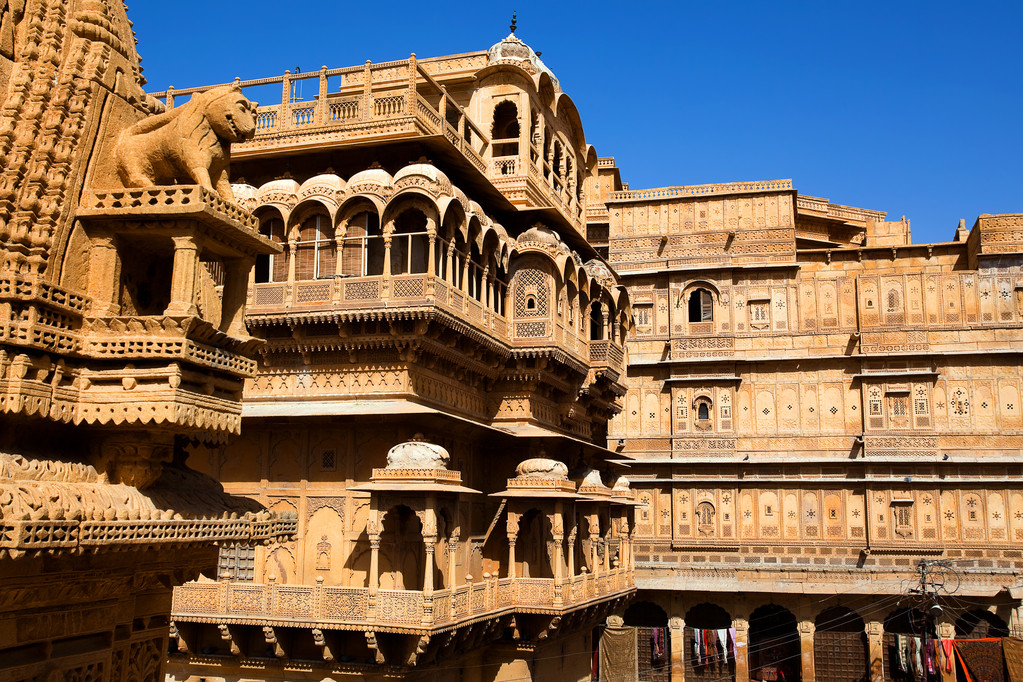Jaisalmer, a city located in the heart of the Thar Desert in Rajasthan, India, is known for its majestic sand dunes, rich culture, and vibrant history. At the heart of this enchanting city stands the magnificent Jaisalmer Fort, also known as Sonar Quila or the Golden Fort. This imposing structure is not only a symbol of royal grandeur but also a prime example of unique Rajput architecture.
The Jaisalmer Fort, built in 1156 AD by Rajput ruler Rao Jaisal, is one of the largest fully preserved fortified cities in the world. Constructed atop Trikuta Hill, the fort dominates the skyline and can be seen from miles away. Its yellow sandstone walls, blending seamlessly with the golden hues of the desert, give the fort its nickname of the Golden Fort.
More:Read About The Tribal Culture Of Odisha
As you enter the fort, you are transported back in time. The narrow winding lanes lined with intricately carved havelis, ancient temples, and bustling markets exude an old-world charm. The fort is not just a historical monument but a living, breathing town with locals residing within its walls. The vibrancy and rich cultural heritage of the fort continue to thrive, making it a captivating destination for travelers.
The architecture of the Jaisalmer Fort is a unique blend of Rajput and Islamic styles. The fort’s walls, built with yellow sandstone blocks, offer a beautiful contrast against the blue sky during the day and take on a golden hue under the setting sun. The craftsmen of the time displayed their skill and artistic brilliance through the intricate carvings and delicate latticework that adorn the fort’s gates, windows, and balconies.
Once inside the fort, you will come across magnificent havelis that reflect the opulence and wealth of their erstwhile owners. The Patwon Ki Haveli is a group of five havelis, each showcasing exquisite craftsmanship and intricate stone carvings. The walls are adorned with delicately carved pillars, arches, and jharokhas (traditional balconies), depicting scenes from mythology and history. The Nathmal Ji Ki Haveli, built by two brothers as a competition, is another splendid example of architectural brilliance. The haveli is adorned with beautiful miniature carvings depicting animals, birds, and daily life activities.
One of the most impressive aspects of the Jaisalmer Fort is its unique defense mechanism. The fort is not only equipped with massive fortified walls but also features four main entrances known as Pols. These Pols are not just gateways but also act as security checkpoints, making it difficult for enemies to penetrate the fort. Additionally, each Pol is designed in a way that restricts the entry of sunlight into the fort, providing natural cooling even in the scorching desert heat.
The Jain Temples within the Jaisalmer Fort are also architectural marvels. These exquisite temples are dedicated to various Jain Tirthankaras and are adorned with intricate carvings, beautiful domes, and stunning sculptures. The towers of the temples are intricately carved with images of deities, celestial beings, and scenes from Jain mythology. The Gyan Bhandar or the library within the temples houses ancient manuscripts and religious texts, providing a glimpse into the rich heritage of Jainism.
Apart from its architectural wonders, the Jaisalmer Fort offers breathtaking panoramic views of the surrounding desert landscape. As you ascend to higher levels of the fort, you are rewarded with stunning vistas of the city below, the vast stretches of the Thar Desert, and the mesmerizing sunset melting into the horizon. The fort’s strategic location not only provided a vantage point for the rulers but also offers visitors a memorable and awe-inspiring experience.
More: Wanted to download Odisha Magazines, visit here
To fully immerse yourself in the unique architecture of the Jaisalmer Fort, spending a night within its walls is highly recommended. Several havelis within the fort have been converted into heritage hotels, providing travelers with an opportunity to experience the grandeur of the bygone era. These heritage hotels offer comfortable rooms, traditional Rajasthani cuisine, and warm hospitality, allowing guests to live like royalty and soak in the magical ambiance of the fort.
In conclusion, the Jaisalmer Fort is a marvel of architecture that exudes a magnetic charm. Its yellow sandstone walls, intricate carvings, and magnificent havelis captivate every visitor who steps foot within its enchanting walls. The fort’s unique blend of Rajput and Islamic styles, along with its strategic location, makes it a must-visit destination for those seeking to explore the rich cultural heritage of Rajasthan. The Jaisalmer Fort stands as a proud testament to the artistic brilliance and architectural prowess of the past, leaving visitors in awe and wonderment.
What is the unique architecture of Jaisalmer Fort?
The unique architecture of Jaisalmer Fort encompasses the use of golden-hued sandstone, intricate carvings, and a strategic layout.
Why is Jaisalmer Fort made of sandstone?
Jaisalmer Fort is made of sandstone as it not only blends harmoniously with the surrounding desert landscape but also provides excellent insulation, keeping the interiors cool in extreme weather conditions.
Are there any special carvings found in Jaisalmer Fort?
Yes, Jaisalmer Fort is known for its exquisite stone carvings. These carvings depict various motifs, including floral patterns, geometrical designs, mythical creatures, and scenes from the daily lives of the people of that era.
How old is Jaisalmer Fort?
Jaisalmer Fort dates back to the 12th century and is one of the oldest continuously inhabited forts in the world.
What is the strategic layout of Jaisalmer Fort?
Jaisalmer Fort is strategically designed with narrow lanes, multiple gates, and high walls to provide better defense against invaders. The layout ensures that every corner of the fort can be easily monitored and defended.

